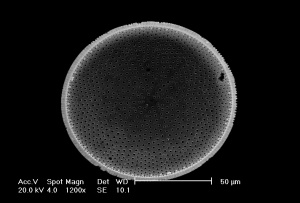Dr Kate Hendry (earth sciences, University of Bristol)
Dr Dominic Lash (Set Ensemble, Bristol)
The oceans play a key role in climate over tens to millions of years. If we’re to understand how climate will change in the future, we need to understand what it was like in the past and how it relates to changes in the atmosphere, the oceans, and life on Earth. To do this, we have to find archives that contain the chemical signature of past ocean and atmosphere conditions, such as deep-sea sediments, fossils and ice cores. For example, we can take tiny fossils of marine life from sediments that are millions of years old, analyse them chemically, and use their chemistry to reconstruct past seawater temperature and nutrients. I specialise on using the chemistry of fossils made from a glass-like material (opal) to reconstruct changes in dissolved silicon. Diatoms – a type of photosynthetic algae – take up a huge amount of carbon dioxide from the atmosphere and lock it away in organic matter. They also need silicon to make their opal skeletons, so if we are to understand changes in carbon uptake from the atmosphere, we have to understand how much dissolved silicon is available, and where, for diatoms to grow. Diatoms appear in the fossil record around the time that the dinosaurs roamed the Earth, and their greater abundance in more recent geological history might well be related to the global cooling that’s been happening since the dinosaurs died out.
preferential uptake (2015)
preferential uptake is inspired by the fact that palaeoclimate records can only be restored indirectly, using what are referred to as “proxies”. Creatures such as diatoms absorb nutrients in distinctive ways, a fact which scientists exploit to reconstruct climate information about the ancient oceans. In the piece, I do not distinguish between diatoms and scientists but consider them all as operators that filter and organise certain inputs to produce certain outputs. To this end, the musicians can serve either as “input” and as “output”, or sometimes as both at once. At times the players will be providing initial material (either fully notated or verbally prompted); at others they “sample” the activity of the other players in various ways, and then replay what they have sampled, “filtered” in various ways. But this replayed sampling might itself be serving as an input for another player, resulting in a complex web of attention and interpretation which will be different not only for every musician in the group, but also, it is hoped, for each member of the audience.
